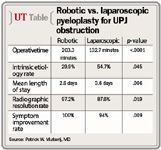Article
Pyeloplasty techniques yield good outcomes
Robotic pyeloplasty demonstrated several operative and outcome advantages over the laparoscopic technique in patients with ureteropelvic junction (UPJ) obstruction.
Washington-Robotic pyeloplasty demonstrated several operative and outcome advantages over laparoscopic technique for patients with ureteropelvic junction (UPJ) obstruction, a retrospective review of a clinical series showed.
Long-term follow-up in 257 cases showed that robotic procedures were associated with a shorter length of stay, higher rate of radiographic resolution of the obstruction, and greater symptom improvement, although both techniques had high rates of symptom improvement. Laparoscopic pyeloplasty was associated with a shorter operative time.
Complication rates were similar with laparoscopic and robotic procedures.

"In tertiary centers, both techniques appear to be effective treatments with good durable outcomes for management of ureteropelvic junction obstruction," added Dr. Mufarrij, who participated in the study while at New York University, New York, working with Michael Stifelman, MD, and co-authors.
Open dismembered pyeloplasty has represented the standard of care for UPJ obstruction for several decades. Recently, minimally invasive techniques have emerged as potential alternatives to open surgery. However, comparative data for the newer techniques remain limited.





